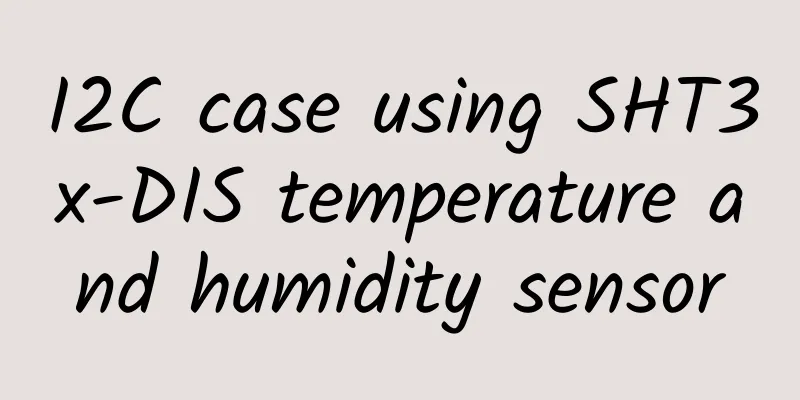I2C case using SHT3x-DIS temperature and humidity sensor

|
To learn more about open source, please visit: 51CTO Open Source Basic Software Community https://ost..com PrefaceThis article will introduce the relevant knowledge of the I2C bus, SHT3x DIS temperature sensor, and how to use OpenHarmony's HDF driver and NAPI framework. 1. I2C bus principleThe I2C bus is a bidirectional two-wire synchronous serial bus developed by Philips. Only two wires are needed to transmit information between devices connected to the bus. I2C communication is point-to-point communication, and there are master devices and slave devices. The master and slave devices communicate through two wires, SDA and SCL, where SDA is the data line and SCL is the clock line. The master device is used to start the bus to transmit data and generate a clock to open the device for transmission. At this time, any addressed device is considered a slave device. The relationship between the master and the slave, the send and receive on the bus is not constant, but depends on the data transmission direction at this time. If the host wants to send data to the slave device, the host first addresses the slave device, then actively sends data to the slave device, and finally the host terminates the data transmission; if the host wants to receive data from the slave device, the master device first addresses the slave device. Then the host receives the data sent by the slave device, and finally the host terminates the receiving process. In this case, the host is responsible for generating a timing clock and terminating data transmission. The communication process includes acknowledgment and response, and clock synchronization. There are certain requirements for the format of the transmitted data bytes. Each byte must be 8 bits. The number of bytes sent each time is not limited, and each byte must be followed by a check bit. Acknowledgment and response: data transmission must have a response, which is generated by the host. In the response, the transmitter pulls the clock line level high, and the receiver pulls the level low to maintain a stable voltage difference; clock synchronization: data transmission only occurs during the high level of the clock signal, so the clock signals of both parties need to be synchronized to ensure the accuracy of the data; 2. Sensor SHT3X DISSensirion SHT3x-DIS humidity and temperature sensors are based on CMOSens® sensor chips, making them smarter, more reliable and more accurate. The SHT3x-DIS features enhanced signal processing capabilities, two unique user-selectable I2C addresses, and communication speeds up to 1MHz. The SHT35-DIS has a typical relative humidity (RH) accuracy of ±1.5% and a typical temperature accuracy of ±0.1°C. The SHT3x-DIS has a footprint of 2.5mm x 2.5mm x 0.9mm (L x W x H) and a supply voltage range of 2.4V to 5.5V. (1) Characteristics
(2) Pin introductionMain pins SDA, SCL, VCC, GND. (3) Communication process
Before starting measurement, the master device must first send a measurement start signal to the sensor. The signal sent is called an I2C write header, which consists of a 7-bit I2C device address and a 0 (0 for writing, 1 for reading), plus a 16-bit measurement command. When the sensor receives the signal, it will pull the SDA signal low first and respond with the ACK signal. At the eighth falling edge of the clock signal, it indicates that the sensor has received the signal from the master device and started measuring.
There are various sensor data collection modes. We can choose different ways to measure to meet different application scenarios. This is the last two bytes of the write header mentioned above, which represent the measurement command. There are two major collection modes.
In addition, other commands are set in the sensor, which can be viewed in the sensor documentation.
When the measurement starts, the master device can receive the signal, and the header should use the read header to change 0 to 1. The last six bytes returned by the sensor are the measured temperature and relative humidity data. Among the six bytes, the upper three bits are two temperatures and one check bit, and the lower three bits are two relative humidity and one check bit, using CRC check. The data conversion formula is as follows: 3. Simple ImplementationThe following code simply demonstrates how to use the sensor without excessive specification requirements. (1) Interface definitionint SendCMD ( char * devName , char addr , uint16_t command ) (2) Main functionint main ( int argc , char * argv []) 4. Using standard system HDF driver implementationUsed: Jiulian Technology unionpi_tiger development board, SHT3x-DIS temperature and humidity sensor, OpenHarmony source code. (1) Configure the product driver (generally, manufacturers will have configured it. If not, you can jump to the official document to view detailed tutorials)Instantiate driver entry:
Configuration properties file:
//device_info.hcs configuration reference // i2c_config.hcs configuration reference (needs to be configured according to the development board used) Instantiate the I2C controller object: Initialize the I2cCntlr member. Instantiate the I2cCntlr members I2cMethod and I2cLockMethod.
(2) One structure and three interfacesI2cMsg structure: used to transmit data carrier, composed of address addr, buffer buf, buffer length len, and signal flag flags. struct I2cMsg { The three interfaces are I2cOpen(), I2cClose(), and I2cTransfer(). //number refers to the bus number mounted by I2C (3) Code
#include //Standard input and output
// Redefine the structure for easy use
int main ( int argc , char ** argv ) So far, the sensor value has been successfully obtained through OpenHarmony's HDF driver. 5. Implementing NAPI(1) Module definition and registration/** (2) Interface definition and registrationint32_t SendCMD ( DevHandle handle , uint16_t command ) (3) Northbound interface
function readI2cBuf (): number ;
import i2chdf from '@ohos.i2chdf' (4) Effect demonstrationSummarizeThe whole idea of the case is centered around the I2C communication process and the SHT3x temperature sensor workflow. In the use of the HDF driver, we will find that we only need one number to get the device handle, which is simpler and clearer than the previous "/dev/i2c-5", which is also one of the characteristics of HDF. The implementation of NAPI connects the entire OpenHarmoy north-south direction, allowing the northbound program to access the temperature and humidity of the sensor through the local interface. To learn more about open source, please visit: 51CTO Open Source Basic Software Community https://ost..com |
<<: What is the difference between Private 4G LTE and Private 5G?
>>: Distributed Fiber Optic Sensors Global Market Report 2023
Recommend
HostUS: Los Angeles VPS starts at $16 per year, with 8 data centers available including Los Angeles
It has been more than a year since I shared infor...
All in one article: 20 industries that 5G can change
The 5G era is coming. What new changes will it br...
5G empowers the transformation and upgrading of the banking industry. How should banks innovate in the 5G era?
Recently, China Mobile and Industrial and Commerc...
Huawei's high-definition intelligent video surveillance solution helps efficient highway operations
Introduction: At present, security technology is ...
HPE Aruba Networking Launches Enterprise-Grade Private 5G Network to Simplify Deployment of Dedicated Cellular Networks
HPE (NYSE: HPE ) today announced the launch of HP...
How to make 5G a reality and what are the current challenges facing 5G?
5G will significantly increase data transmission ...
As technology giants rush to enter the market, what kind of development will the satellite communications field usher in?
In recent years, the global satellite communicat...
Application of SRv6 Technology in Home Network
Labs Guide In order to adapt to the development o...
PacificRack: $8/year KVM-512MB/10GB/1TB/Los Angeles data center
PacificRack has launched the Winter Sales promoti...
Design and implement a TCP protocol semi-connected port scanner
A student fan sent a question: From the title, yo...
edgeNAT newly launched VPS in Los Angeles with 40% off monthly payment and 50% off annual payment, US/Hong Kong/Korea data centers
edgeNAT recently opened a new cabinet in the Core...
Relationship-aware routing and global traffic scheduling · SOSP 2019
[[345832]] "Read the Papers" is a serie...
Digital-vm New Year 50% off, KVM VPS monthly payment starts from 2 US dollars, 8 computer rooms in the United States/Japan/Singapore
I haven't shared information about Digital-vm...
Tencent Cloud New Year Procurement Season Hot Sale 2C2G3M Annual Payment Starting from 61 Yuan, Receive 1188-7700 Yuan Vouchers
Tencent Cloud is launching the 2024 Spring Procur...
ZJI 20% off, 440 yuan/month-2*E5-2620/16G memory/240G SSD/10M (CN2+BGP)/Korean server
ZJI was founded in 2011. It is the original well-...









